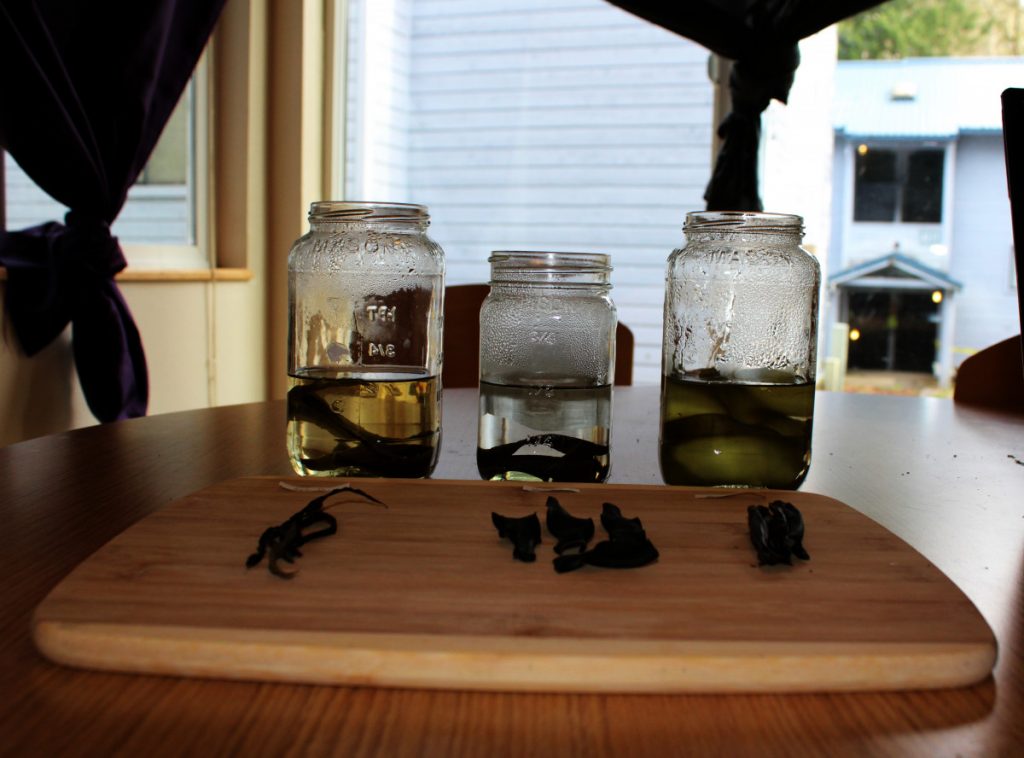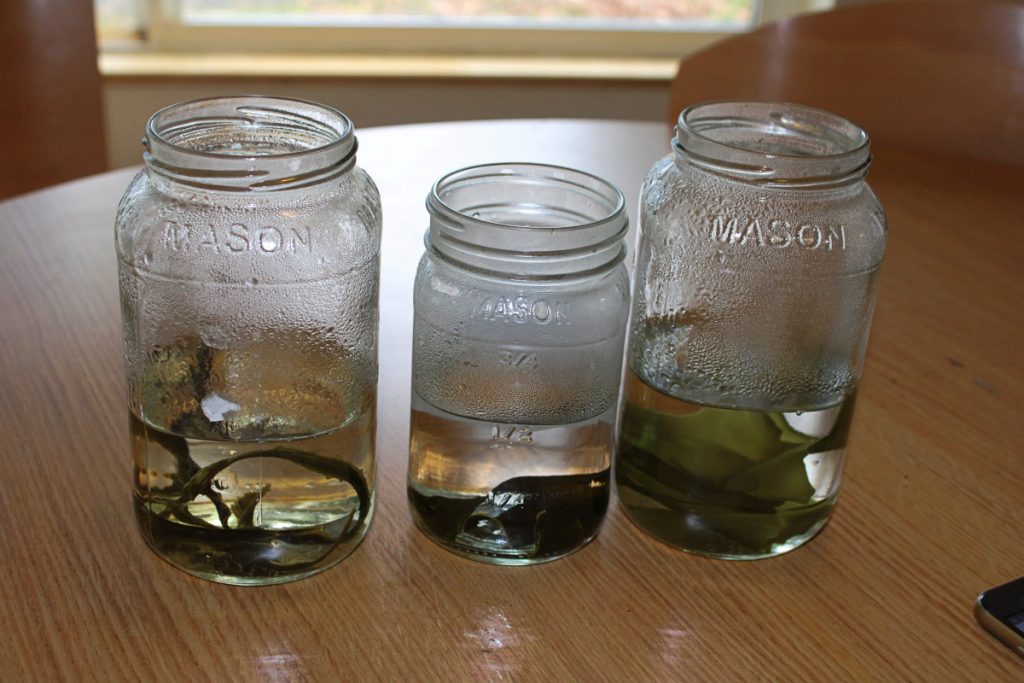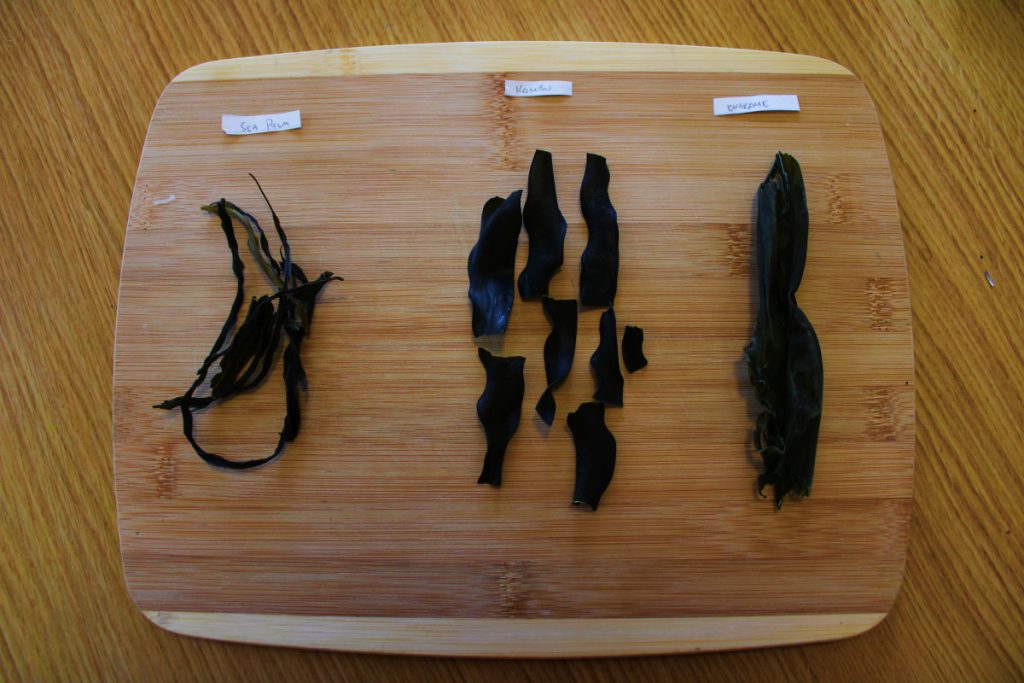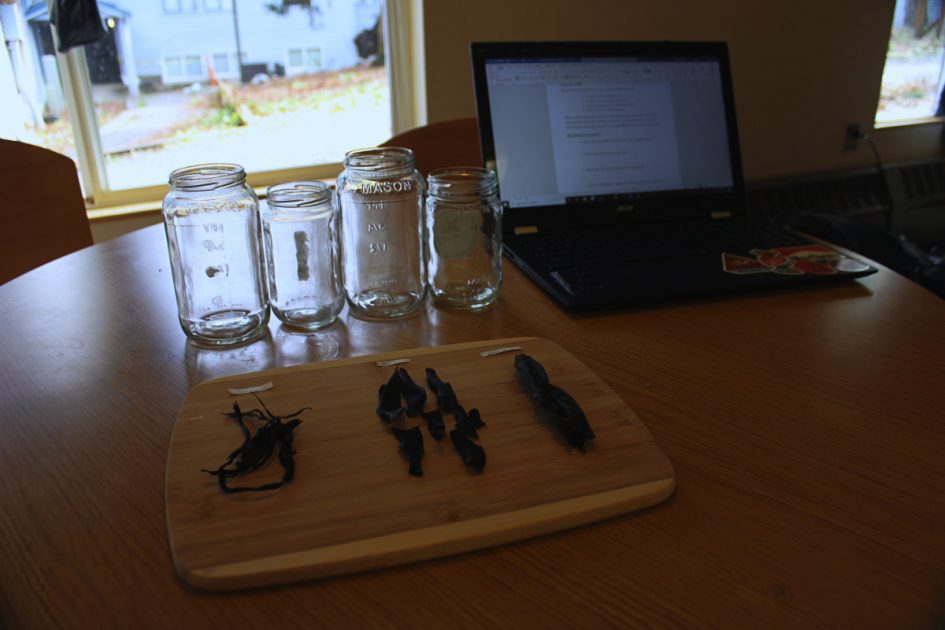#4a: Film Series: Program Questions in Scenes and Overview
For this week I chose video “How Chef Jacob Harth Harvests and Cooks Wild Seaweed” in order to explore the question of what factors influence the quality of the foods? Especially their flavor. I’m titling this scene “the life of seaweed”. I have chosen minutes (1-5). In this scene Chef Jacob Harth explains that “basically any of the seaweeds are edible. The only time you want to avoid it is if the water quality is poor. Anything that could be a potential hazard with the water will be a hazard for the seaweed, for sure.” And goes on to show us how he harvests the seaweed. As he’s harvesting it, he brings up a lot of how different the types of seaweed and kelp are and how their textures can get tattered because of the tide coming in and out. This scene really compelled my learning about how the different factors in the ocean influence the quality of the seaweed by really explaining the different types and textures of the seaweed and how outside factors in the ocean can affect the quality of the seaweed.
The film I chose was “3D Ocean Farms with Bren Smith of GreenWave”. Min (0-3:30) in order to answer the question of what is meant by regenerative agriculture and how can it guide us to food sustainability? I am titling this scene “3D Farming + creativity= food sustainability”. As I watch Bren Smiths video, he discusses his 3D ocean farming technique which he says “to use the full water column to in order to grow vertically to grow a mix of shellfish and seaweeds for local food but also fertilizer, animal feed, biofuel and mitigating climate change and creating blue-green jobs at the same time.” He then goes on to talk about his idea for the vertical farming system he labels “3-D Ocean Farming: The Last Deadliest Catch”. Which is essentially this amazing vertical farming system that allows them to grow shellfish vertically and get as much use out of that spot (only 20 acres!) in the ocean while growing restorative species. He then goes on to discuss his kelp season and how they have a negative carbon footprint and the other thing he grows on the same system. He describes it as he owns a process not a property right, he is protecting rather than privatizing the ocean. This scene compelled my learning about regenerative agriculture and how it can guide us to food sustainability by listening to Bren describe how his system he’s worked so hard to make his vertical farming system and how it is mitigating climate change and not taking up as much space in the oceans.
Wk 7: Geoduck and Seaweed

- Three Feet Under: A Duckumentary, Evergreen Library streaming service (Dir. Justin Bookey, 63 min, 2003).
- Why this $300 clam is so important to Native Americans and China (Al Jazeera, 20 min, 2019)
- Meet Eddie Huang, the memoirist who inspired ‘Fresh Off the Boat’, Soraya Nadia McDonald, Washington Post, 2013. Scroll down for film trailer (3 min).
- How Chef Jacob Harvests and Cooks Wild Seaweed (Eater, 11 min, 2020)
Wk 8: Geoduck and Seaweed
- Introducing Humboldt State University’s New Seaweed Farm, Humboldt Online (2 min, 2020)
- 3D Ocean Farms with Bren Smith of GreenWave (Classy Org, 20 min, 2016)
- Meet the Women Growing the California Seaweed Economy, Civil Eats (website), Alexander Sammon (2018) along with viewing Zanzibar’s Seaweed (5 min, 2019) and Zanzibar’s Female Seaweed Farmers (5 min, 2019), CNN on Evergreen Library’s AVON streaming service (log in required)
- Seaweed Farming in Washington State Agenda: Videos of UW Sea Grant Conference. Choose any 90 minutes of talks, but begin with “Seaweed Farming Overview: Species and Applications” (Thomas Mumford, 44 min, 2019)
#4b: (un)Natural Histories
- a mollusk so valuable that gangsters have traded it for narcotics: the geoduck
- Most of the harvest goes to China, where cooks in Shanghai and Beijing simmer the clams in hot pots. A single geoduck can fetch $60 in a Hong Kong fish market.
- Geoducks can reach 14 pounds and live more than 150 years
#4c: Regenerative Agriculture
- the potential of managing seaweed production to mitigate climate change by sequestering CO2 has not yet been fully incorporated into the emergent concept of Blue Carbon, referring to climate change mitigation strategies based on the capacity of marine plants to bind CO2
- the use of seaweed biomass as biofuel directly replacing fossil fuels (e.g., Kraan, 2013; Chen et al., 2015), and/or replacing food or feed production systems with intense CO2 emission footprints by seaweed-based food systems, which have much lower life-cycle CO2 emission (Fry et al., 2012). Indeed, a seaweed-based Blue Carbon program has been developed in Korea (Chung et al., 2013; Sondak and Chung, 2015), providing an initial step in this direction
- In groups of farming rafts that together cover more than 10,000 acres (much larger than any U.S.-based operation), plants are wound along parallel lines of rope to float like loose scarves. Others waft underwater and get sucked up by vacuums.
- Acidifying seas make it hard for juvenile shellfish to form shells, wrecking aquaculture industries and natural ecosystems. Add in the increasing temperature, pollution and excess nutrients that flow off land to create dangerous low-oxygen conditions, and they become inhospitable oceans.
#4d: Case Study Tasting Research
GEODUCK “TASTING”
- WHAT DOES GEODUCK TASTE LIKE?
- WHAT IS “Q”?
- Q is the texture of things(chewy)
- LABEL THE PARTS OF THE GEODUCK:
1.shell
2. tip
3. siphon
4. belly
5. mantle
6. foot
7. gills
8. gut
9. sack
BREAK TIME
Please heat up your water during this time, and set up the following 4 cups:
- One piece of kombu (roughly 3”x1”)
- A couple pieces of wakame (roughly 3”x1”)
- The equivalent amount of sea palm (about 8 pieces)
- Your favorite tea + a piece of wakame
When we return from the break, you’ll pour boiling water in each of the seaweed cups and let them steep while Annie tells us about her seaweed ILC. Wait to add water to your favorite tea until we start tasting the seaweed, so the tea is not oversteeped (it will be the last thing we taste).
SEAWEED TASTING
- WHAT ARE THE THREE SEAWEEDS WE ARE TASTING TODAY?
- Sea palm
- Kombu
- Wakame
- WHAT TYPE OF SEAWEED ARE THEY?
- Sea palm- edible seaweed
- Kombu- edible kelp
- Wakame- edible seaweed
- WHAT ARE THE HEALTH BENEFITS OF SEAWEED?
- Vitamins and minerals
- Protective antioxidants
- Fiber and polysaccharides
- Iodine and tyrosine
- May reduce heart disease risk
- WHAT IS THE BIGGEST THREAT TO THE OCEAN RIGHT NOW? Why?
- Unsustainable fishing is the biggest threat to the ocean right now because it not only affects the sea life but it harms the livelihoods of people all over the world in need of food.
SEAWEED #1: Sea Palm

Tea
Color: dark yellowish green
Aroma: fresh, oceany, earthy
Texture: watery, not slimy at all
Mouthfeel: moist
Taste: earthy, umami
Aftertaste: not much
Dried
Color: dark green
Aroma: faint, earthy
Texture: hard, crunchy
Mouthfeel: glutinous
Taste: salty, bitter
Aftertaste: salty, bitter, oceany
Reconstituted
Color: mix of light and dark green
Aroma: earthy, vegetative
Texture: soft, crunchy, fiberous
Mouthfeel: moist, slippery, glutinous
Taste: umami
Aftertaste: clean
SEAWEED #2:Kombu
Tea
Color: Dark green
Aroma: smells like puget sound, salty
Texture: kinda thick and watery
Mouthfeel: a little thicker
Taste: umami, earthy,
Aftertaste: _tastes like the sea is in my mouth_
Dried
Color: _dark green, blackish__
Aroma: __faint savory smell_____
Texture: hard, chewy
Mouthfeel: melt in mouth
Taste: salty
Aftertaste: lingering
Reconstituted
Color: yellow-green
Aroma: almost a sweet smell
Texture: firm, squeaky, fiberous
Mouthfeel: stringy, silky
Taste: umami
Aftertaste: refreshing sea taste
SEAWEED #3: Wakame
Tea
Color: Light yellowish green
Aroma: light
Texture: moist, refreshing
Mouthfeel: kind of refreshing, not overbearing
Taste: bitter
Aftertaste: a little sour, earthy
Dried
Color: dark green
Aroma: eggy, earthy
Texture: crunchy, light
Mouthfeel: crunchy
Taste: bitter, salty
Aftertaste: lingering
Reconstituted
Color: light green, kinda blue tint
Aroma: herbaceous
Texture: slimy,smooth
Mouthfeel: fatty, slippery
Taste: umami
Aftertaste: clean
TEA EXPERIMENT
Tea: vanilla Comoro
Seaweed:sea palm, kombu, and wakame
Color: light-ish brown
Aroma: all I can smell is seaweed
Texture: watery
Mouthfeel: moist
Taste: umami
Aftertaste: lingering with a hint of vanilla

REFLECTION
- WHAT WERE SOME OF YOUR FAVORITE GEODUCK AND/OR SEAWEED DISHES PRESENTED TODAY?
- I think making sushi out of geoduck and eating it raw was kind of my favorite dish because I feel like in order to cook with it you need to know how it tastes without spices and other things
- HAVE YOU EVER EATEN GEODUCK? If yes, please tell the story. How was it prepared? What did you think?
- I have not eaten geoduck
- WHAT OTHER FOOD HAVE YOU EATEN THAT HAVE “Q”?
- Boba, ive tried a lot of different noodles
- WOULD YOU ORDER A GEODUCK SHIPPED TO YOUR HOUSE? If yes, how much would you be willing to pay for it? If no, why?
- I would, I would probably spend about $20-$30 so I can make different dishes and compare tastes
- WHAT WOULD YOU MAKE WITH GEODUCK IF THE SKY WAS THE LIMIT?
- I would either try and make a steak or burgers out of geoduck
- HAVE YOU EATEN SEAWEED BEFORE? If yes, what was your most memorable time? If no, what stopped you from eating it?
- Yes, my best friend back home brought seaweed chips to school and that was the first time I tried it and loved it
- WHAT TEA DID YOU EXPERIMENT WITH ADDING SEAWEED TO TODAY? Did they complement each other, or detract? What kind of tea do you think would pair well?
- Vanilla Comoro, they definitely did not complement each other. I don’t think tea should be mixing with seaweed.
- HOW DID YOU PREPARE THE LEFTOVER SEAWEED? Share recipe details if you want, and Emily might feature it on her website!
- I made seaweed and rice with coconut sauce
- WHAT DID YOU LEARN FROM ANNIE’S RESEARCH STRUCTURE AND FOCUS? Please share your notes.
- Annie discussed her seaweed and her ILC surrounding it. I learned that umami was only discovered 20 years ago
- She wrote about her findings at the asian markets and how lists don’t specify the types of seaweed to use in recipes and things like that
- I also learned about her finding her understanding of merroir and the different flavors she tasted while exploring the varieties of seaweed
#4e: Stuckey’s Taste Book Experiments
- Of the 5 basic tastes, which do you believe your body craves the most?
- I believe my body craves savory the most
- Do you have a specific (or favorite) way to enjoy that basic taste?
- it used to be meat but since coming to Evergreen and now its mac and cheese in order to get the savory satisfaction I wanted.
1st Experiment Questions:
- What was your initial reaction to the bitter nail tea with nothing added to it?
- I really didnt like it
- How did the bitterness change between the different cups containing sugar and/or salt?
- it became a little sweeter in the sugar and the salt didnt do much other than subsidise the bitter taste of the tea
- There seems to be two groups of coffee/tea drinkers: people who enjoy the drink in its unaltered form, and others who like modify it with fats and sugars. Give different example of a way we humans alter classically bitter foods or drink to make them more palatable.
- people have started adding things to their water in order to change the “boring” favor of water
- What are your thoughts on regionally/culturally acquired flavor preferences? Do you believe that flavor preference is a learned behavior, instinctual, or a mixture of both? When you taste a flavor, when does its objectivity end and your subjectivity begin?
- I think its a mix of both
2nd Experiment Questions: (OPTIONAL)
- Do you enjoy grapefruit? Why do you think some people love the flavor of raw grapefruit, and others can’t stand it?
- I love grapefruit and the sweet but bitter taste of it
- How did the addition of sugar alter the flavor of the grapefruit?
- it just made it less bitter
- How did the addition of the salt alter the flavor of the grapefruit?
- the salt didnt do much
- Did the addition of the sugar and/or salt change your opinion on grapefruit?
- no
- Seeing as these two experiments both consisted of altering a food or drink by adding salt or sugar, did you find any similarities or differences between the two experiments?
- examining the different flavors by adding salt and sugar allowed me to get a new sense of flavor with the grapefruit and tea
#4f: Sustainable Entrepreneurship
- described in detail the adverse impacts of seaweed harvesting at small, artisanal and commercial scales on areas of conservation importance, protected and priority habitats and species, including disturbance of birds and wildlife, disruption of food webs, damage to substrata, habitat destruction, localized biodiversity changes, and changes in particle-size distribution in sediments. Direct effects on the seaweed population include mortalities due to increased growth rate and cover of other algae which are not harvested, such as filamentous green algae and the brown seaweed, Fucus vesiculosus, which outcompete the desired species, and die-back due to increased predation.
- one challenge faced by farmers in these remote areas is low 2016 United Nations 6 profits due to high shipping costs. This disadvantage is exacerbated by the dependence of farmers on processors for the procurement of their farming materials and their lack of farm-management skills.
#4g: Climate and Resilience Event Series/Seminar
#4h: Foodoir: Your Story of Tasting Place
“I help with the five and six year olds, anyway. I’ve been taking care of little kids since I was one, and I’m tired of it. I think, though, that if someone doesn’t help Amy now, someday she’ll do something a lot worse than burning down her family’s garage. “(39-40)
while reading this quote it brought out a time in my life where I was taking care of all 3 of my nephews everyday. Having a schedule, feeding them, doing almost everything for them and then coming to college I had to learn how to kind of take time to myself and be productive in things I love doing.
#4i: Bibliography
- https://www.un.org/Depts/los/global_reporting/WOA_RPROC/Chapter_14.pdf
- https://www.frontiersin.org/articles/10.3389/fmars.2017.00100/full?RefID=EM2287_MktPartner_VOCES15#B31
- https://crosscut.com/2019/12/could-seaweed-be-washingtons-next-cash-crop
- https://www.smithsonianmag.com/science-nature/geoducks-happy-as-clams-52966346/
- file:///C:/Users/cash%20america/Downloads/Butler,%20Octavia%20-%20Parable%20of%20the%20Sower.pdf%20(%20PDFDrive%20)%20(4).pdf


Leave a Reply